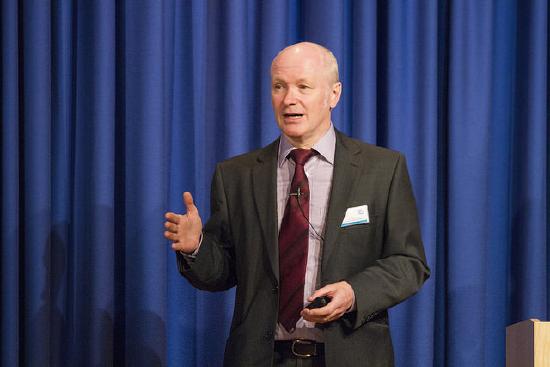8.4: Leadership and Small Group Communication
- Last updated
- Save as PDF
- Page ID
- 106473
Learning Objectives
- Discuss the various perspectives on how and why people become leaders.
- Compare and contrast various leadership styles.
It’s important to point out that although a group may have only one official leader, other group members play important leadership roles. Making this distinction also helps us differentiate between leaders and leadership (Hargie, 2011). The leader is a group role that is associated with a high-status position and may be formally or informally recognized by group members. Leadership is a complex set of beliefs, communication patterns, and behaviors that influence the functioning of a group and move a group toward the completion of its task. A person in the role of leader may provide no or poor leadership. Likewise, a person who is not recognized as a “leader” in the title can provide excellent leadership. In the remainder of this section, we will discuss some approaches to the study of leadership, leadership styles, and leadership and group dynamics.
Why and How People Become Leaders
Before we move onto specific approaches to studying leadership, let’s distinguish between designated and emergent leaders. In general, some people gravitate more toward leadership roles than others, and some leaders are designated while others are emergent (Hargie, 2011). Designated leaders are officially recognized in their leadership role and may be appointed or elected by people inside or outside the group. Designated leaders can be especially successful when they are sought out by others to fulfill and are then accepted in leadership roles. On the other hand, some people seek out leadership positions not because they possess leadership skills and have been successful leaders in the past but because they have the drive to hold and wield power. Many groups are initially leaderless and must either designate a leader or wait for one to emerge organically. Emergent leaders gain status and respect through engagement with the group and its task and are turned to by others as a resource when leadership is needed. Emergent leaders may play an important role when a designated leader unexpectedly leaves. We will now turn our attention to three common perspectives on why some people are more likely to be designated leaders than others and how leaders emerge in the absence of or in addition to a designated leader.

Leaders Emerge Because of Their Traits
The trait approach to studying leadership distinguishes leaders from followers based on traits, or personal characteristics (Pavitt, 1999). Some traits that leaders, in general, share are related to physical appearance, communication ability, intelligence, and personality (Cragan & Wright, 1991). In terms of physical appearance, designated leaders tend to be taller and more attractive than other group members. This could be because we consciously and/or subconsciously associate a larger size (in terms of height and build, but not body fat) with strength and strength with good leadership. As far as communication abilities, leaders speak more fluently, have a more confident tone, and communicate more often than other group members. Leaders are also moderately more intelligent than other group members, which is attractive because leaders need good problem-solving skills. Interestingly, group members are not as likely to designate or recognize an emergent leader that they perceive to be exceedingly more intelligent than them. Last, leaders are usually more extroverted, assertive, and persistent than other group members. These personality traits help get these group members noticed by others, and expressivity is often seen as attractive and as a sign of communication competence.
Leaders Emerge Because of the Situation
Leaders emerge differently in different groups, but there are two stages common to each scenario (Bormann & Bormann, 1988). During this first stage, about half of the group’s members are eliminated from the possibility of being the group’s leader. Remember that this is an informal and implicit process—not like people being picked for a kickball team or intentionally vetted. The second stage of leader emergence is where a more or less pronounced struggle for leadership begins. Although the two leading candidates don’t overtly fight with each other or say, “I should be leader, not you!” they both take strong stances in regards to the group’s purpose and try to influence the structure, procedures, and trajectory for the group. The candidate who retreats will still enjoy a relatively high status in the group and be respected for vying for leadership. The second-place candidate may become a nuisance for the new emergent leader, questioning his or her decisions. Rather than excluding or punishing the second-place candidate, the new leader should give him or her responsibilities within the group to make use of the group member’s respected status.

Leaders Emerge Based on Communication Skill and Competence
This final approach to the study of leadership is considered a functional approach because it focuses on how particular communication behaviors function to create the conditions of leadership. This last approach is the most useful for communication scholars and for people who want to improve their leadership skills because leadership behaviors (which are learnable and adaptable) rather than traits or situations (which are often beyond our control) are the primary focus of study. As we’ve already learned, any group member can exhibit leadership behaviors, not just a designated or emergent leader. Therefore leadership behaviors are important for all of us to understand even if we don’t anticipate serving in leadership positions (Cragan & Wright, 1991).

Leadership Styles
Given the large amount of research done on leadership, it is not surprising that there are several different ways to define or categorize leadership styles. In general, effective leaders do not fit solely into one style in any of the following classifications. Instead, they are able to adapt their leadership style to fit the relational and situational context (Wood, 1977). One common way to study leadership style is to make a distinction among autocratic, democratic, and laissez-faire leaders (Lewin, Lippitt, & White, 1939). These leadership styles can be described as follows:
- Autocratic leaders set policies and make decisions primarily on their own, taking advantage of the power present in their title or status to set the agenda for the group.
- Democratic leaders facilitate group discussion and like to take input from all members before making a decision.
- Laissez-faire leaders take a “hands-off” approach, preferring to give group members freedom to reach and implement their own decisions.
While this is a frequently cited model of leadership styles, we will focus in more detail on a model that was developed a few years after this one. I choose to focus on this later model because it offers some more specifics in terms of the communicative elements of each leadership style. The four leadership styles used in this model are directive, participative, supportive, and achievement-oriented (House & Mitchell, 1974).
Directive Leaders
Directive leaders help provide psychological structure for their group members by clearly communicating expectations, keeping a schedule and agenda, providing specific guidance as group members work toward the completion of their task, and taking the lead on setting and communicating group rules and procedures. Although this is most similar to the autocratic leadership style mentioned before, it is more nuanced and flexible. The originators of this model note that a leader can be directive without being seen as authoritarian. To do this, directive leaders must be good motivators who encourage productivity through positive reinforcement or reward rather than through the threat of punishment.

A directive leadership style is effective in groups that do not have a history and may require direction to get started on their task. It can also be the most appropriate method during crisis situations in which decisions must be made under time constraints or other extraordinary pressures. When groups have an established history and are composed of people with unique skills and expertise, a directive approach may be seen as “micromanaging.” In these groups, a more participative style may be the best option.
Participative Leaders
Participative leaders work to include group members in the decision-making process by soliciting and considering their opinions and suggestions. When group members feel included, their personal goals are more likely to align with the group and organization’s goals, which can help productivity. In addition to consulting group members for help with decision-making, participative leaders also grant group members more freedom to work independently. This can lead group members to feel trusted and respected for their skills, which can increase their effort and output. The participative method of leadership is similar to the democratic style discussed earlier, and it is a style of leadership practiced in many organizations that have established workgroups that meet consistently over long periods of time. US companies began to adopt a more participative and less directive style of management in the 1980s after organizational scholars researched teamwork and efficiency in Japanese corporations. Japanese managers included employees in decision-making, which blurred the line between the leader and other group members and enhanced productivity. These small groups were called "quality circles" because they focused on group interaction intended to improve quality and productivity (Cragan & Wright, 1991).
Supportive Leaders
Supportive leaders show concern for their followers’ needs and emotions. They want to support group members’ welfare through a positive and friendly group climate. These leaders are good at reducing the stress and frustration of the group, which helps create a positive climate and can help increase group members’ positive feelings about the task and other group members. Supportive leaders do not provide unconditionally positive praise. They competently provide constructive criticism in order to challenge and enhance group members’ contributions. A supportive leadership style is more likely in groups that are primarily relational rather than task-focused. For example, support groups and therapy groups benefit from a supportive leader. While maintaining positive relationships is an important part of any group’s functioning, most task-oriented groups need to spend more time on tasks than social functions in order to efficiently work toward the completion of their task.
Achievement-Oriented Leaders
Achievement-oriented leaders strive for excellence and set challenging goals, constantly seeking improvement and exhibiting confidence that group members can meet their high expectations. These leaders often engage in systematic social comparison, keeping tabs on other similar high-performing groups to assess their expectations and the group’s progress. This type of leadership is similar to what other scholars call transformational or visionary leadership and is often associated with leaders like former Apple CEO Steve Jobs, talk show host and television network CEO Oprah Winfrey, former president Bill Clinton, and business magnate turned philanthropist Warren Buffett. Achievement-oriented leaders are likely less common than the other styles, as this style requires a high level of skill and commitment on the part of the leader and the group. Although rare, these leaders can be found at all levels of groups ranging from local school boards to Fortune 500 companies. Certain group dynamics must be in place in order to accommodate this leadership style. Groups for which an achievement-oriented leadership style would be effective are typically intentionally created and are made up of members who are skilled and competent in regard to the group’s task. In many cases, the leader is specifically chosen because of his or her reputation and expertise, and even though the group members may not have a history of working with the leader, the members and leader must have a high degree of mutual respect.
“Getting Plugged In”: Steve Jobs as an Achievement-Oriented Leader
“Where can you find a leader with Jobs’ willingness to fail, his sheer tenacity, persistence, and resiliency, his grandiose ego, his overwhelming belief in himself?” (Deutschman, 2012) This closing line of an article following the death of Steve Jobs clearly illustrates the larger-than-life personality and extraordinary drive of achievement-oriented leaders. Jobs, who founded Apple Computers, was widely recognized as a visionary with a brilliant mind during his early years at the helm of Apple (from 1976 to 1985), but he hadn’t yet gained respect as a business leader. Jobs left the company and later returned in 1997. After his return, Apple reached its height under his leadership, which was now enhanced by the business knowledge and skills he gained during his time away from the company. The fact that Jobs was able to largely teach himself the ins and outs of business practices is a quality of achievement-oriented leaders, who are constantly self-reflective and evaluate their skills and performance, making adaptations as necessary.
Achievement-oriented leaders also often possess good instincts, allowing them to make decisions quickly while acknowledging the potential for failure but also showing a resiliency that allows them to bounce back from mistakes and come back stronger. Rather than bringing in panels of experts, presenting ideas to focus groups for feedback, or putting a new product through market research and testing, Jobs relied on his instincts, which led to some embarrassing failures and some remarkable successes that overshadowed the failures. Although Jobs made unilateral decisions, he relied heavily on the creative and technical expertise of others who worked for him and were able to make his creative, innovative, and some say genius ideas reality. As do other achievement-oriented leaders, Jobs held his group members to exceptionally high standards and fostered a culture that mirrored his own perfectionism. Constant comparisons to other technological innovators like Bill Gates, CEO of Microsoft, pushed Jobs and those who worked for him to work tirelessly to produce the “next big thing.” Achievement-oriented leaders like Jobs have been described as maniacal, intense, workaholics, perfectionists, risk-takers, narcissists, innovative, and visionary. These descriptors carry positive and negative connotations but often yield amazing results when possessed by a leader, the likes of which only seldom come around.
- Do you think Jobs could have been as successful had he employed one of the other leadership styles? Why or why not? How might the achievement-oriented leadership style be well suited for a technology company like Apple or the technology field in general?
- In what circumstances would you like to work for an achievement-oriented leader, and why? In what circumstances would you prefer not to work with an achievement-oriented leader, and why?
- Do some research on another achievement-oriented leader. Discuss how that leader’s traits are similar to and/or different from those of Steve Jobs.
“Getting Real”: Leadership as the Foundation of a Career
As we’ve already learned, leaders share traits, some more innate and naturally tapped into than others. Successful leaders also develop and refine leadership skills and behaviors that they are not “born with.” Since much of leadership is skill and behavior-based, it is never too early to start developing yourself as a leader. Whether you are planning to start your first career path fresh out of college, you’ve returned to college in order to switch career paths, or you’re in college to help you advance more quickly in your current career path, you should have already been working on your leadership skills for years; it’s not something you want to start your first day on the new job. Since leaders must be able to draw from a wealth of personal experience in order to solve problems, relate to others, and motivate others to achieve a task, you should start to seek out leadership positions in school and/or community groups. Since you may not yet be sure of your exact career path, try to get a variety of positions over a few years that are generally transferrable to professional contexts. In these roles, work on building a reputation as an ethical leader and as a leader who takes responsibility rather than playing the “blame game.” Leaders still have to be good team players and often have to take on roles and responsibilities that other group members do not want. Instead of complaining or expecting recognition for your “extra work,” accept these responsibilities enthusiastically and be prepared for your hard work to go unnoticed. Much of what a good leader does occurs in the background and isn’t publicly praised or acknowledged. Even when the group succeeds because of your hard work as the leader, you still have to be willing to share that praise with others who helped, because even though you may have worked the hardest, you didn’t do it alone.
As you build up your experience and reputation as a leader, be prepared for your workload to grow and your interpersonal communication competence to become more important. Once you’re on your career path, you can draw on this previous leadership experience and volunteer or step up when the need arises, which can help you get noticed. Of course, you have to be able to follow through on your commitment, which takes discipline and dedication. While you may be excited to prove your leadership chops in your new career path, I caution you about taking on too much too fast. It’s easy for a young and/or new member of a work team to become overcommitted, as more experienced group members are excited to have a person to share some of their work responsibilities with. Hopefully, your previous leadership experience will give you confidence that your group members will notice. People are attracted to confidence and want to follow people who exhibit it. Aside from confidence, good leaders also develop dynamism, which is a set of communication behaviors that conveys enthusiasm and creates an energetic and positive climate. Once confidence and dynamism have attracted a good team of people, good leaders facilitate quality interaction among group members, build cohesion, and capitalize on the synergy of group communication in order to come up with forward-thinking solutions to problems. Good leaders also continue to build skills in order to become better leaders. Leaders are excellent observers of human behavior and are able to assess situations using contextual clues and nonverbal communication. They can then use this knowledge to adapt their communication to the situation. Leaders also have a high degree of emotional intelligence, which allows them to better sense, understand, and respond to others’ emotions and to have more control over their own displays of emotions. Last, good leaders further their careers by being reflexive and regularly evaluating their strengths and weaknesses as a leader. Since our perceptions are often skewed, it’s also good to have colleagues and mentors/supervisors give you formal evaluations of your job performance, making explicit comments about leadership behaviors. As you can see, the work of a leader only grows more complex as one moves further along a career path. But with the skills gained through many years of increasingly challenging leadership roles, a leader can adapt to and manage this increasing complexity.
- What leadership positions have you had so far? In what ways might they prepare you for more complex and career-specific leadership positions you may have later?
- What communication competencies do you think are most important for a leader to have and why? How do you rate in terms of the competencies you ranked as most important?
- Who do you know who would be able to give you constructive feedback on your leadership skills? What do you think this person would say? (You may want to consider actually asking the person for feedback).
Key Takeaways
- Leaders fulfill a group role that is associated with status and power within the group that may be formally or informally recognized by people inside and/or outside of the group. While there are usually only one or two official leaders within a group, all group members can perform leadership functions, which are a complex of beliefs, communication patterns, and behaviors that influence the functioning of a group and move a group toward the completion of its tasks.
- There are many perspectives on how and why people become leaders:
- Designated leaders are officially recognized in their leadership roles and may be appointed or elected.
- Emergent leaders gain status and respect through engagement with the group and its task and are turned to by others as a resource when leadership is needed.
- The trait approach to studying leadership distinguishes leaders from followers based on traits or personal characteristics, such as physical appearance, communication ability, intelligence, and personality. While this approach is useful for understanding how people conceptualize ideal leaders, it doesn’t offer communication scholars much insight into how leadership can be studied and developed as a skill.
- Situational context also affects how leaders emerge. Different leadership styles and skills are needed based on the level of the structure surrounding a group and on how group interactions play out in initial meetings and whether or not a leadership struggle occurs.
- Leaders also emerge based on communication skill and competence, as certain communication behaviors function to create the conditions of leadership. This approach is most useful to communication scholars because in it leadership is seen as a set of communication behaviors that are learnable and adaptable rather than traits or situational factors, which are often beyond our control.
- Leaders can adopt a directive, participative, supportive, or achievement-oriented style.
- Directive leaders help provide psychological structure for their group members by clearly communicating expectations, keeping a schedule and agenda, providing specific guidance as group members work toward the completion of their task, and taking the lead on setting and communicating group rules and procedures.
- Participative leaders work to include group members in the decision-making process by soliciting and considering their opinions and suggestions.
- Supportive leaders show concern for their followers’ needs and emotions.
- Achievement-oriented leaders strive for excellence and set challenging goals, constantly seeking improvement and exhibiting confidence that group members can meet their high expectations.
Exercises
- In what situations would a designated leader be better than an emergent leader, and vice versa? Why?
- Think of a leader that you currently work with or have worked with who made a strong (positive or negative) impression on you. Which leadership style did he or she use most frequently? Cite specific communication behaviors to back up your analysis.
- Getting integrated: Teachers are often viewed as leaders in academic contexts along with bosses/managers in professional, politicians/elected officials in civic, and parents in personal contexts. For each of these leaders and contexts, identify some important leadership qualities that each should possess, and discuss some of the influences in each context that may affect the leader and his or her leadership style.
References
Bormann, E. G., and Nancy C. Bormann, Effective Small Group Communication, 4th ed. (Santa Rosa, CA: Burgess CA, 1988), 130–33.
Cragan, J. F., and David W. Wright, Communication in Small Group Discussions: An Integrated Approach, 3rd ed. (St. Paul, MN: West Publishing, 1991), 120.
Deutschman, A., “Exit the King,” The Daily Beast, September 21, 2011, accessed August 23, 2012, http://www.thedailybeast.com/newsweek/2011/08/28/steve-jobs-american-genius.html.
Fiedler, F. E., A Theory of Leadership Effectiveness (New York: McGraw-Hill, 1967).
French Jr., J. R. P., and Bertram Raven, “The Bases of Social Power,” in Studies in Social Power, ed. Dorwin Cartwright (Ann Arbor, MI: Institute for Social Research, 1959), 150–67.
Hargie, O., Skilled Interpersonal Interaction: Research, Theory, and Practice (London: Routledge, 2011), 456.
House, R. J., and Terrence R. Mitchell, “Path-Goal Theory of Leadership,” Journal of Contemporary Business 3 (1974): 81–97.
Lewin, K., Ronald Lippitt, and Ralph K. White, “Patterns of Aggressive Behavior in Experimentally Created ‘Social Climates,’” Journal of Social Psychology 10, no. 2 (1939): 269–99.
Pavitt, C., “Theorizing about the Group Communication-Leadership Relationship,” in The Handbook of Group Communication Theory and Research, ed. Lawrence R. Frey (Thousand Oaks, CA: Sage, 1999), 313.
Wood, J. T., “Leading in Purposive Discussions: A Study of Adaptive Behavior,” Communication Monographs 44, no. 2 (1977): 152–65.


